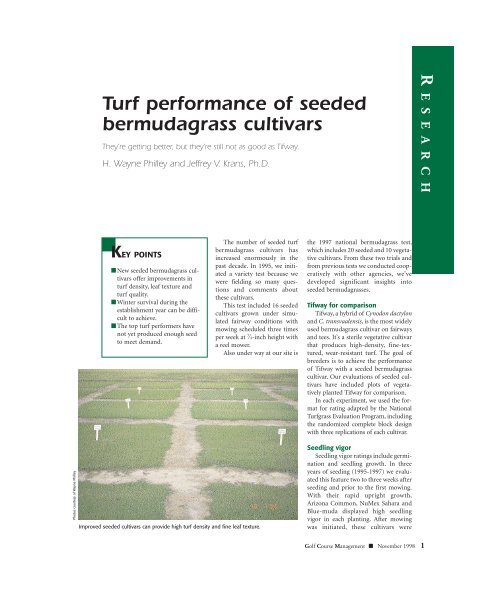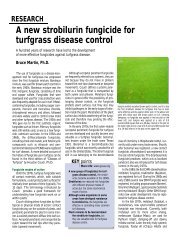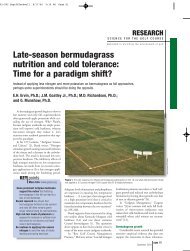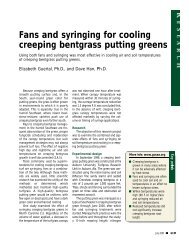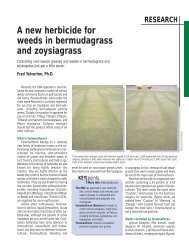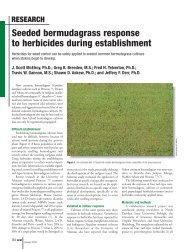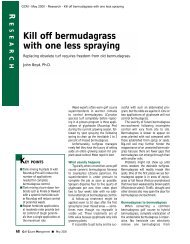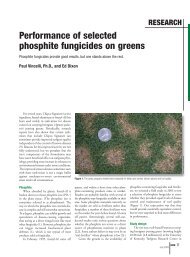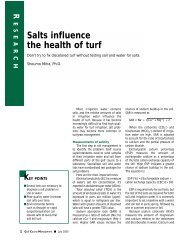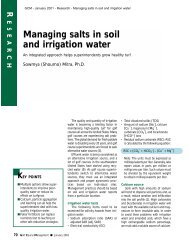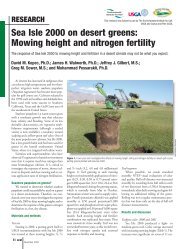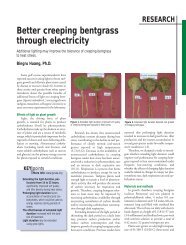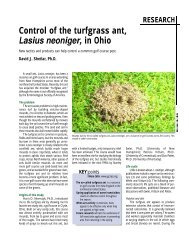Turf performance of seeded bermudagrass cultivars - GCSAA
Turf performance of seeded bermudagrass cultivars - GCSAA
Turf performance of seeded bermudagrass cultivars - GCSAA
Create successful ePaper yourself
Turn your PDF publications into a flip-book with our unique Google optimized e-Paper software.
<strong>Turf</strong> <strong>performance</strong> <strong>of</strong> <strong>seeded</strong><strong>bermudagrass</strong> <strong>cultivars</strong>They’re getting better, but they’re still not as good as Tifway.H. Wayne Philley and Jeffrey V. Krans, Ph.D.R E S E A R C HKEY POINTS■ New <strong>seeded</strong> <strong>bermudagrass</strong> <strong>cultivars</strong><strong>of</strong>fer improvements inturf density, leaf texture andturf quality.■ Winter survival during theestablishment year can be difficultto achieve.■ The top turf performers havenot yet produced enough seedto meet demand.The number <strong>of</strong> <strong>seeded</strong> turf<strong>bermudagrass</strong> <strong>cultivars</strong> hasincreased enormously in thepast decade. In 1995, we initiateda variety test because wewere fielding so many questionsand comments aboutthese <strong>cultivars</strong>.This test included 16 <strong>seeded</strong><strong>cultivars</strong> grown under simulatedfairway conditions withmowing scheduled three timesper week at 3 ⁄4-inch height witha reel mower.Also under way at our site isthe 1997 national <strong>bermudagrass</strong> test,which includes 20 <strong>seeded</strong> and 10 vegetative<strong>cultivars</strong>. From these two trials andfrom previous tests we conducted cooperativelywith other agencies, we’vedeveloped significant insights into<strong>seeded</strong> <strong>bermudagrass</strong>es.Tifway for comparisonTifway, a hybrid <strong>of</strong> Cynodon dactylonand C. transvaalensis, is the most widelyused <strong>bermudagrass</strong> cultivar on fairwaysand tees. It’s a sterile vegetative cultivarthat produces high-density, fine-textured,wear-resistant turf. The goal <strong>of</strong>breeders is to achieve the <strong>performance</strong><strong>of</strong> Tifway with a <strong>seeded</strong> <strong>bermudagrass</strong>cultivar. Our evaluations <strong>of</strong> <strong>seeded</strong> <strong>cultivars</strong>have included plots <strong>of</strong> vegetativelyplanted Tifway for comparison.In each experiment, we used the formatfor rating adapted by the National<strong>Turf</strong>grass Evaluation Program, includingthe randomized complete block designwith three replications <strong>of</strong> each cultivar.Photos courtesy <strong>of</strong> Wayne PhilleyImproved <strong>seeded</strong> <strong>cultivars</strong> can provide high turf density and fine leaf texture.Seedling vigorSeedling vigor ratings include germinationand seedling growth. In threeyears <strong>of</strong> seeding (1995-1997) we evaluatedthis feature two to three weeks afterseeding and prior to the first mowing.With their rapid upright growth,Arizona Common, NuMex Sahara andBlue-muda displayed high seedlingvigor in each planting. After mowingwas initiated, these <strong>cultivars</strong> wereGolf Course Management ■ November 1998 1
anked near the bottom in turf <strong>performance</strong>ratings. Low-growing <strong>cultivars</strong>,including Princess, Sundance, Savannah(4), and PST-R69C, displayed lowerseedling vigor but higher <strong>performance</strong>after initiation <strong>of</strong> mowing. Seeded<strong>bermudagrass</strong> has been well known foreasy establishment because <strong>of</strong> rapid germinationand growth. Compared withother warm-season species, none <strong>of</strong> the<strong>cultivars</strong> evaluated had unacceptableseedling vigor.<strong>Turf</strong> quality<strong>Turf</strong> quality ratings are the mostused tool for evaluating turfgrasses. Inour evaluation <strong>of</strong> <strong>bermudagrass</strong>es weconsidered several components to arriveat quality scores — uniformity, density,leaf texture, color and the presence orabsence <strong>of</strong> seedheads. Quality ratingswere made twice monthly during eachgrowing season.The <strong>seeded</strong> <strong>cultivars</strong> that maintainedthe highest quality scores includedPrincess, Sundance and Savannah. Most<strong>cultivars</strong> achieved quality that wassignificantly higher than ArizonaCommon, including NuMex Sahara.Princess, Sundance, Savannah,Sultan, Sunstar, Del Sol, ED1, Mirage,Sundevil II, MD2, Sonesta, PST-R69C,SW1-11, J-1224, J-540 and OKS 95-1 alldisplayed significantly higher turf qualitythan NuMex Sahara for at least onegrowing season in one or more experiments.None <strong>of</strong> the <strong>seeded</strong> <strong>cultivars</strong>achieved the turf quality <strong>of</strong> Tifway.Leaf textureLeaf texture (blade width) and turfdensity have improved more than anyother aspect <strong>of</strong> turf quality as a result <strong>of</strong>breeders’ work with <strong>seeded</strong> <strong>bermudagrass</strong>.These traits are usually linked —the finer the leaf blades, the higher theturf density. In our evaluations,Princess, Sundance and Savannah displayedthe finest leaf texture among<strong>seeded</strong> <strong>cultivars</strong>. Sultan, Sundevil II, DelSol, Sunstar and Mirage were also significantlyfiner than NuMex Sahara andArizona Common. Tifway was significantlyfiner than any <strong>seeded</strong> cultivar.Guymon <strong>bermudagrass</strong> had the coarsestleaf texture in our experiments, followedby ED5.<strong>Turf</strong> densitySeeded <strong>cultivars</strong> receiving the highestdensity ratings (number <strong>of</strong> shoots perunit area) were Princess, Sundance andSavannah. Other <strong>cultivars</strong> with significantlyhigher density than NuMexSahara included Sultan, Sunstar,Sundevil II, Mirage and ED1. Density <strong>of</strong>Tifway was significantly greater thanany <strong>seeded</strong> <strong>cultivars</strong>.ColorWe did not observe great differencesin genetic color among <strong>seeded</strong><strong>bermudagrass</strong> <strong>cultivars</strong>. Most differencesamong plots on any date <strong>of</strong> ratingscould be attributed to injury ordefoliation. Cultivars that grow moreupright, such as Arizona Common, havea greater tendency to scalp, which affectscolor. When comparing healthy leaves,differences among <strong>seeded</strong> <strong>cultivars</strong>appear to be subtler. The color <strong>of</strong> Tifwayis different from <strong>seeded</strong> <strong>cultivars</strong>.continuedAvailability <strong>of</strong> the top <strong>cultivars</strong>Sources for the top three <strong>seeded</strong> <strong>bermudagrass</strong> <strong>cultivars</strong>in our trials — Princess, Sundance and Savannah —acknowledge that breeding for turf quality <strong>of</strong>ten reducesseed yield.Seeds West Inc. reports the initial seed production <strong>of</strong>Princess was low. Only very limited seed was available in1998. Better availability is expected in 1999. Sultan,another noteworthy cultivar from the same company, ispresently available in good supply.Lesco informed us that seed yield <strong>of</strong> Sundance hadbeen unacceptable. Out <strong>of</strong> Sundance, Sundance II hasbeen selected for improved seed yield. We look forward toevaluating Sundance II’s turf quality beginning in 1999.Sunstar is commercially available from the same companyin good supply.Pure Seed Testing Inc. reports that the early yield <strong>of</strong>Savannah has been encouraging. Supply is limited at presentbut should be good by 2000.R E S E A R C HGolf Course Management ■ November 1998 2
Cultivars evaluatedcontinued from p. 63Rhizome densityBermudagrasses have stolons(aboveground stems) and rhizomes(belowground). Rhizomes can aidin recovery when the turf surfaceis removed or injured. Rhizomescontribute to winter survival andsod strength.To evaluate the quantity <strong>of</strong> rhizomesin each cultivar, we dried out plugsfrom each plot and weighed rhizomestem material. Dry weights weredivided by the volume <strong>of</strong> the sample toarrive at the rhizome density. Ourresults showed that rhizome densityenhanced winter survival but didn’talways correlate with shoot density.Guymon, for example, received thelowest turf-density rating, but rankedR E S E A R C HThe following are the <strong>seeded</strong> turf <strong>bermudagrass</strong> <strong>cultivars</strong> evaluated at Mississippi State Universityfrom 1995 to 1998.ExperimentalCultivar designation Source Years evaluatedED1 Cascade International Seed Co. 1995,1996, 1997, 1998MD2 Cascade International Seed Co. 1995,1996, 1997, 1998ED5 Cascade International Seed Co. 1996,1997, 1998MD8 Cascade International Seed Co. 1997, 1998Blue-muda DSM-200 Desert Sun Marketing 1995,1996, 1997, 1998Pyramid CD 90183 International Seeds Inc. 1995,1996, 1997, 1998Mirage CD 90173 International Seeds Inc. 1996,1997, 1998Sundance B14 Lesco 1995,1996, 1997, 1998Sunstar B618 Lesco 1995,1996, 1997, 1998Del Sol B26-14 <strong>Turf</strong> Merchants Inc. 1995,1996, 1997, 1998Sundevil II Medalist <strong>of</strong> America 1995,1997, 1998Sultan FMC-6 Seeds West Inc. 1995,1996, 1997, 1998Princess FMC-77 Seeds West Inc. 1995,1996, 1997, 1998SW 1-7 Seeds West Inc. 1997, 1998SW 1-11 Seeds West Inc. 1997, 1998NuMex Sahara NMS-1 Seeds West Inc. 1995,1996, 1997, 1998Arizona Common Seeds West Inc. 1995,1996, 1997, 1998Sonesta NMS-3 O.M. Scott & Sons Co. 1995Savannah PST-R64 Pure Seed Testing Inc. 1996,1997, 1998Panama PST-R63 Pure Seed Testing Inc. 1997, 1998PST-R69C Pure Seed Testing Inc. 1997, 1998J-540 Olsen-Fennel Seed Co. 1997, 1998Blackjack Olsen-Fennel Seed Co. 1997, 1998J-1224 Jacklin Seed Co. 1997, 1998Jackpot J-912 Jacklin Seed Co. 1997, 1998Shangri La Zajac Performance Seed 1997, 1998Majestic H&H Seed Co. 1997, 1998OKS 95-1 Oklahoma State Univ. 1997, 1998Guymon GX59 Johnston Seed Co. 1995,1996, 1997, 1998Golf Course Management ■ November 1998 3
consistently highest among <strong>seeded</strong> <strong>cultivars</strong>in rhizome density. Princess, one<strong>of</strong> the denser <strong>cultivars</strong>, had few rhizomeson some dates <strong>of</strong> measurement.Other <strong>cultivars</strong> with high rhizomedensity were Sundance and ED1. Most<strong>cultivars</strong> were not significantly differentfrom Arizona Common. Tifwayproduced more rhizomes than any<strong>seeded</strong> cultivar.Spring green-upSpring green-up <strong>of</strong> <strong>bermudagrass</strong>should not be confused with winter survival.We applied the spring green-uprating in years when temperatures hadbeen mild and there was no significantwinterkill.Spring green-up indicates the rate atwhich the <strong>cultivars</strong> break winter dormancyand begin spring growth. In thetest that we <strong>seeded</strong> in 1996, all plots survivedthe two winters that followed, but<strong>cultivars</strong> responded differently to thetwo different winters. In 1997, Guymondisplayed the earliest green-up, whileTifway and Arizona Common rankedamong the latest. In 1998, Tifway wasearly, while Guymon ranked among thelatest, with Arizona Common.Savannah displayedimproved springgreen-up over NuMexSahara and ArizonaCommon in bothyears <strong>of</strong> rating. Severalyears <strong>of</strong> evaluation areneeded to properlyrank the spring greenup<strong>of</strong> these <strong>cultivars</strong>.The minimum air temperature was near0 F.Local golf courses and some sodfarms experienced extensive winterkill<strong>of</strong> Tifway. Many fairways requiredreplanting, and Tifway sod was in shortsupply. Should fairways be plantedwith seed?Our Tifway plots established fromvegetative plugs in July displayed 55 percentwinter survival. Among the <strong>seeded</strong><strong>cultivars</strong>, Guymon averaged 17 percentsurvival while other <strong>cultivars</strong> displayed0 to 3 percent. Most <strong>of</strong> the same <strong>cultivars</strong>were re<strong>seeded</strong> in June 1996 withonly minimal winter injury observedthe following spring.Our plots for the 1997 national<strong>bermudagrass</strong> test were planted July 10,1997. All plots — vegetative and <strong>seeded</strong>— were well established and under routinemowing before frost and winterdormancy. The 1997-1998 winter wasmild with the minimum air temperatureapproximately 20 F. Even so, the<strong>seeded</strong> <strong>cultivars</strong> suffered severe winterinjury. Vegetative <strong>cultivars</strong> (includingTifway) in the same test and <strong>seeded</strong> cul-continuedR E S E A R C HWinter survivalWe believe thepotential for winterkillduring theestablishment year is acritical factor indeciding whether toestablish <strong>bermudagrass</strong>from seed. Thefirst <strong>of</strong> these tests was<strong>seeded</strong> on June 22,1995. The followingwinter in Mississippiwas considered severe.After the severe winter <strong>of</strong> 1995-96, Tifway <strong>bermudagrass</strong> displayed better survival than any <strong>seeded</strong> cultivar.Golf Course Management ■ November 1998 4
continued from p. 65tivars in the adjacent 1996 plantingshowed almost no injury.Among the <strong>seeded</strong> <strong>cultivars</strong> in the1997 test, Princess and the experimental<strong>cultivars</strong> PST-R69C, SW 1-11 andOKS 95-1 had the best winter survival(greater than 80 percent survival comparedwith Arizona Common at 18 percent).Because this was a mild winter itshould not be concluded that the<strong>seeded</strong> <strong>cultivars</strong> with higher winter survivalin the establishment year are morecold tolerant.For our region we recommend seeding<strong>bermudagrass</strong> in spring and earlysummer if it will be maintained at lowmowing heights because close mowingincreases winterkill <strong>of</strong> <strong>bermudagrass</strong>. Iflate seeding is necessary, then raising themowing height late in the growing seasonmay increase chances <strong>of</strong> success.AvailabilitySeed production is <strong>of</strong>ten traded awayas breeders strive to improve the turfqualities <strong>of</strong> <strong>cultivars</strong>. That means it’s<strong>of</strong>ten hardest to obtain seed for thebest grasses.We contacted the sources <strong>of</strong> the topthree <strong>seeded</strong> <strong>bermudagrass</strong>es —Princess, Sundance and Savannah —and found that the initial seed production<strong>of</strong> Princess (Seeds West Inc.) waslow, and the seed was not widely availablein 1998. Better availability isexpected in 1999. Seed yield <strong>of</strong>Sundance (Lesco) has been unacceptable.Sundance II has been selected forimproved seed yield. We look forward toevaluating Sundance II’s turf qualitybeginning in 1999. Supply <strong>of</strong> Savannah(Pure Seed Testing) is also limited atpresent but should be good by 2000.SummaryNew <strong>seeded</strong> <strong>bermudagrass</strong> <strong>cultivars</strong><strong>of</strong>fer improvements in turf density, leaftexture and turf quality. Lower and moreprostrate growth habit enables these new<strong>cultivars</strong> to perform at lower mowingheights than Arizona Common.Late seeding combined with lowmowing height may result in poor wintersurvival during the establishment year.Although the top turf performershave not yet produced enough seed tomeet demand, the future looks brightfor <strong>seeded</strong> <strong>bermudagrass</strong>. And although<strong>seeded</strong> <strong>cultivars</strong> have not met the <strong>performance</strong><strong>of</strong> Tifway, this goal is muchnearer than it was just a decade ago. ■References1. Alderson, J., and W.C. Sharp. 1994. Grass varietiesin the United States. USDA Agric.Handbook No. 170. U.S. Government PrintingOffice, Washington, DC.2. Baltensperger, A.A. 1989. Registration <strong>of</strong>‘NuMex Sahara’ <strong>bermudagrass</strong>. Crop Science29:1326.3. Baltensperger, A.A., and V. Meier. 1993.Registration <strong>of</strong> ‘Sonesta’ <strong>bermudagrass</strong>. CropScience 33:876.4. Fraser, M.L., and C.A. Rose-Fricker. 1998.Registration <strong>of</strong> ‘Savannah’ <strong>bermudagrass</strong>. CropScience 38:279.5. Samudio, S.H., and A.D. Brede. 1997.Registration <strong>of</strong> ‘Jackpot’ <strong>bermudagrass</strong>. CropScience 37:1380.6. Samudio, S.H., and A.D. Brede. 1998.Registration <strong>of</strong> ‘Cheyenne’ <strong>bermudagrass</strong>.Crop Science 38:279.7. Samudio, S.H., and A.D. Brede. 1998.Registration <strong>of</strong> ‘Sundevil’ <strong>bermudagrass</strong>. CropScience 38:537-538.8. Taliaferro, C.M., R.M. Ahring and W.L.Richardson. 1983. Registration <strong>of</strong> ‘Guymon’<strong>bermudagrass</strong>. Crop Science 23:1219.R E S E A R C HEven after a mild winter in Mississippi in 1997-98, <strong>bermudagrass</strong> <strong>cultivars</strong> <strong>seeded</strong> in July 1997(front) displayed severe winter injury compared with second-year plots (back) <strong>seeded</strong> inJune 1996.H. Wayne Philley is senior research assistant inMississippi State University’s department <strong>of</strong> plantand soil sciences. Jeffrey V. Krans, Ph.D., is pr<strong>of</strong>essor<strong>of</strong> agronomy in the department.Golf Course Management ■ November 1998 5


